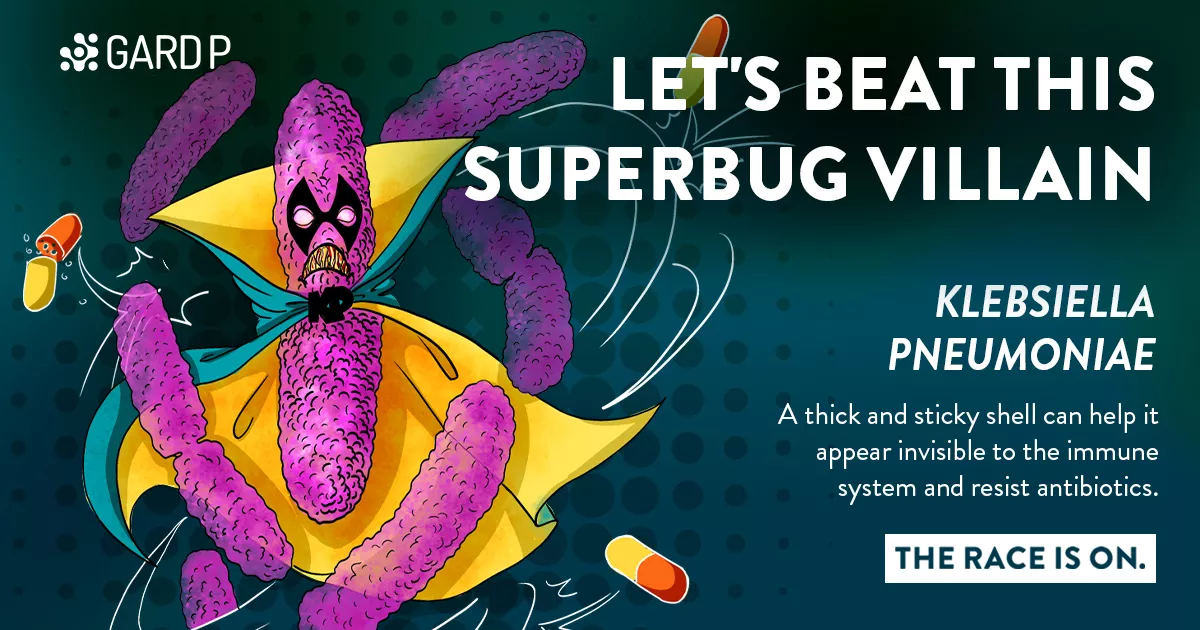Meet Klebsiella pneumoniae
What is it?
Drug-resistant Klebsiella pneumoniae infections are associated with more than 600,000 deaths a year globally – more than malaria – and are responsible for many types of infection that are increasingly untreatable, including pneumonia, bloodstream (sepsis) and urinary tract infections, wound or surgical site infections, and meningitis. By itself K. pneumoniae accounts for a third of all Gram-negative bacterial infections globally, making it a major source of antibiotic resistance.
How is it spread?
While often detected in healthcare settings, it is a global concern as it is able to spread through person-to-person contact typically via the faecal-oral route, as well as through contact with objects, including contaminated medical equipment and surfaces, or through the ingestion of contaminated food. Antibiotic-resistant genes can pass easily between K. pneumoniae strains through a method called horizontal gene transfer.
Like some other bacteria, K. pneumoniae has the ability to form biofilms, a community of bacteria that forms a matrix on surfaces that is very resilient and difficult to kill. K. pneumoniae is also known for its ability to surround itself in a thick, sticky coating called a capsule. This helps it evade the human immune system, because it makes it more difficult for white blood cells to engulf and destroy the bacteria. People with immature immune systems, such as newborn babies, or people who are immune-compromised, are particularly vulnerable to infection by this bacterium because their immune systems cannot ‘see’ the capsule, which can act like a sort of ‘invisibility cloak’.

Where is it found?
Drug-resistant K. pneumoniae were first detected in the USA in the mid-20th century, but have since become a problem in countries in all corners of the world. The first case of extensively drug-resistant hypervirulent K. pneumoniae – which is resistant to all but one class of antibiotic and very good at infecting people – was detected in Taiwan in 1986. Since then it has spread epidemically through China, South Korea and Japan, with cases now reported in India and Europe.
Similarly, in 2000 in North Carolina, USA, a gene that causes resistance to certain types of antibiotics was first identified in K. pneumoniae, a common cause of bloodstream infections (sepsis) with high morbidity and mortality. Within a couple of years, these resistant genes were detected in New York and then Israel. By 2008, they had reached Italy, Colombia, the UK, Sweden and India, and today can be found across the globe.
Drug resistance
Drug-resistant mechanisms notwithstanding, K. pneumoniae belongs to a particularly hardy group of bacteria, called Gram-negative bacteria. Unlike Gram-positive bacteria, these have an additional outer layer protecting them that make it more difficult for antibiotics to enter the cell and kill them. K. pneumoniae also possess proteins that can stop antibiotics that have entered its outer layer from penetrating any further by pumping them back out of the cell.
K. pneumoniae has in recent decades acquired a wide variety of resistance mechanisms to a range of antibiotics. For drugs such as penicillins and cephalosporins, these mechanisms include altering the proteins to which the antibiotics bind in order to work, and the production of beta-lactamases, enzymes that inactivates these antibiotics.